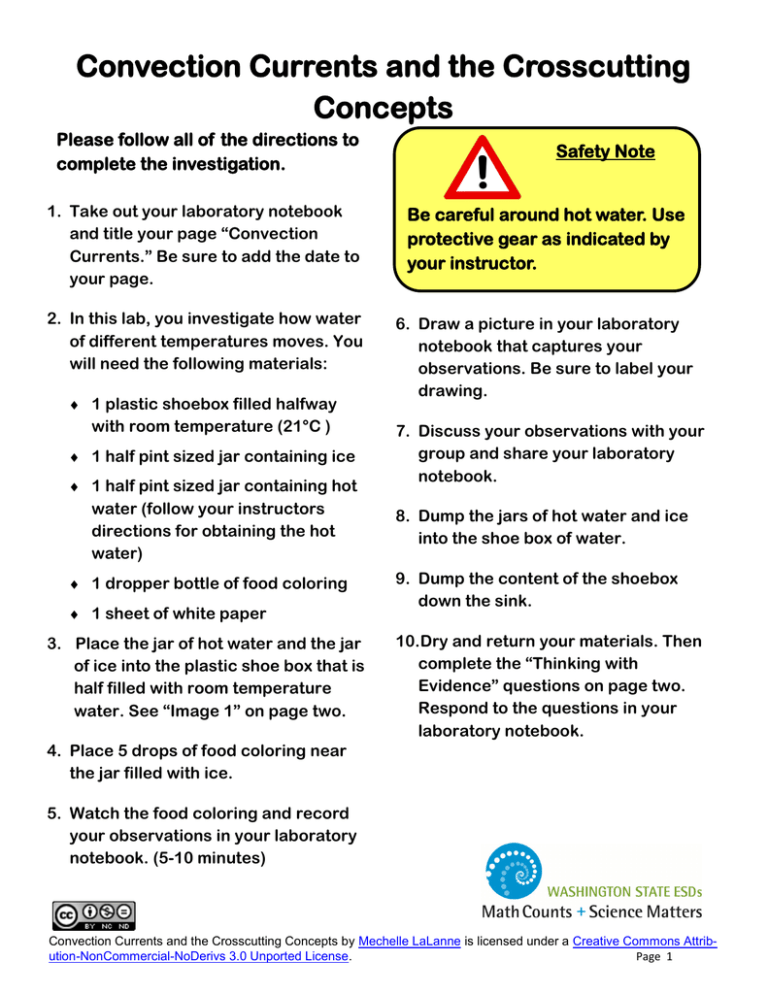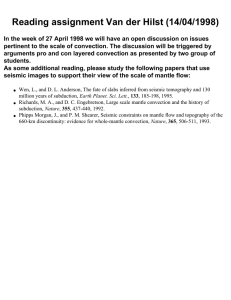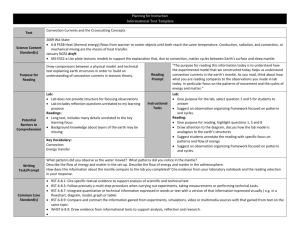Convection Currents and the Crosscutting Concepts
advertisement

Convection Currents and the Crosscutting Concepts Please follow all of the directions to complete the investigation. Safety Note 1. Take out your laboratory notebook and title your page “Convection Currents.” Be sure to add the date to your page. Be careful around hot water. Use protective gear as indicated by your instructor. 2. In this lab, you investigate how water of different temperatures moves. You will need the following materials: 6. Draw a picture in your laboratory notebook that captures your observations. Be sure to label your drawing. 1 plastic shoebox filled halfway with room temperature (21°C ) 1 half pint sized jar containing ice 1 half pint sized jar containing hot water (follow your instructors directions for obtaining the hot water) 1 dropper bottle of food coloring 1 sheet of white paper 3. Place the jar of hot water and the jar of ice into the plastic shoe box that is half filled with room temperature water. See “Image 1” on page two. 7. Discuss your observations with your group and share your laboratory notebook. 8. Dump the jars of hot water and ice into the shoe box of water. 9. Dump the content of the shoebox down the sink. 10.Dry and return your materials. Then complete the “Thinking with Evidence” questions on page two. Respond to the questions in your laboratory notebook. 4. Place 5 drops of food coloring near the jar filled with ice. 5. Watch the food coloring and record your observations in your laboratory notebook. (5-10 minutes) Convection Currents and the Crosscutting Concepts by Mechelle LaLanne is licensed under a Creative Commons Attribution-NonCommercial-NoDerivs 3.0 Unported License. Page 1 Thinking with Evidence 1. What patterns did you observe as the water moved? 5. Describe the flow of energy and matter in the set-up. 2. What caused the water to move the way it did? What was the effect of the water movement? 6. How does the shape of the plastic shoebox influence the movement of the water? 3. How would the movement be different if this were on a larger scale like the ocean? 7. What would happen if the water in the jars became the same temperature as the water in the plastic shoebox? 4. Describe how this set-up is a system. (Boundaries, flows, inputs, outputs, etc.) 5 drops of food coloring Image 1 Half pint jar filled with hot water Plastic shoe box half filled with room temperature water Half pint jar filled with ice Convection Currents and the Crosscutting Concepts by Mechelle LaLanne is licensed under a Creative Commons Attribution-NonCommercial-NoDerivs 3.0 Unported License. Page 2 Convection Currents in the Atmosphere Hadley cell At the equator the solar radiation is greatest and masses of moist air are warmed at the surface and rise. The masses of air rise into the upper atmosphere to the top of the troposphere at an altitude of about 14 kilometers. The air then flows horizontally towards the poles. The air cools at the 30th parallels and becomes dense enough to sink back to the surface of the earth. The air then returns back to the equator. Ferrel cell The Ferrel Cell experiences a reversed flow pattern compared to the Hadley cell, occurring between the 30th and 60th parallels. Warm moist air that has continued from the Hadley cell rises around the 60th parallel. The rising warm air cools as it increases altitude and then moves towards the equator. The air sinks where it encounters the cooled air from the top of the Hadley Cell at around 30 degrees latitude. There, the air from both the Hadley cell and Ferrel split at the surface to maintain each cell's circulation. The Ferrel Cell is the least secure of the three cells because it is not as well defined. Because of its position between the Hadley and Polar Cells, it has no extreme heat to start convection and no extreme cold to induce the sinking of the air cell. Polar cell The Polar cell has a similar flow pattern as the Hadley Cell. Though the air at higher latitudes is much cooler and drier than that at the equator, the air masses at the 60th parallel are still warm enough for convection to occur. Warm air rises at around the 60th parallel and moves towards the poles. When the air reaches the polar areas, it cools considerably and sinks then moves back towards the 60th parallel along the surface of the earth. Convection Currents and the Crosscutting Concepts by Mechelle LaLanne is licensed under a Creative Commons Attribution-NonCommercial-NoDerivs 3.0 Unported License. Page 3 Solar Heating and Coriolis Forces Since winds are just molecules of air, they are also subject to Coriolis forces. Winds are basically driven by Solar heating. As the adjacent (highly idealized) image indicates, Solar heating on the Earth has the effect of producing three major convection zones in each hemisphere. If solar heating were the only thing influencing the weather, we would then expect the prevailing winds along the Earth's surface to either be from the North or the South, depending on the latitude. However, the Coriolis force deflects these wind flows to the right in the Northern hemisphere and to the left in the Southern hemisphere. This produces the prevailing surface winds illustrated in the adjacent figure. For example, between 30 degrees and 60 degrees North latitude the solar convection pattern would produce a prevailing surface wind from the South. However, the Coriolis force deflects this flow to the right and the prevailing winds at these latitudes are more from the West and Southwest. They are called the prevailing Westerlies. Thinking with Evidence 1. What patterns did you notice in each cell type? 2. What caused the air to move the way it did? What was the effect of the air movement? 3. How would the movement be different if temperatures were warmer in the northern latitudes? 4. Describe how each cell is a system and how the systems interact. 5. Describe the flow of energy and matter in the atmosphere. 6. How does the shape of the earth and its rotation influence the movement of the air? 7. What would happen if the earth’s temperatures were to increase at the polar regions? 8. How does this information about the atmosphere relate to the lab you completed? Cite evidence from your laboratory notebook and the reading selection in your response. Images and text obtained from: http://csep10.phys.utk.edu/astr161/lect/earth/coriolis.html http://minerva.union.edu/failinge/ earths_convection_cells.html http://www.geography-revision.co.uk/pages/climatology/ atmospheric-circulation/ Convection Currents and the Crosscutting Concepts by Mechelle LaLanne is licensed under a Creative Commons Attribution-NonCommercial-NoDerivs 3.0 Unported License. Page 4 Convection Currents in the Mantle The tectonic plates do not randomly drift or wander about the Earth's surface; they are driven by definite yet unseen forces. Although scientists can neither precisely describe nor fully understand the forces, most believe that the relatively shallow forces driving the lithospheric plates are coupled with forces originating much deeper in the Earth. What drives the plates? From seismic and other geophysical evidence and laboratory experiments, scientists generally agree with Harry Hess' theory that the plate-driving force is the slow movement of hot, softened mantle that lies below the rigid plates. This idea was first considered in the 1930s by Arthur Holmes, the English geologist who later influenced Harry Hess' thinking about seafloor spreading. Holmes speculated that the circular motion of the mantle carried the continents along in much the same way as a conveyor belt. However, at the time that Wegener proposed his theory of continental drift, most scientists still believed the Earth was a solid, motionless body. We now know better. As J. Tuzo Wilson eloquently stated in 1968, "The earth, instead of appearing as an inert statue, is a living, mobile thing." Both the Earth's surface and its interior are in motion. Below the lithospheric plates, at some depth the mantle is partially molten and can flow, albeit slowly, in response to steady forces applied for long periods of time. Just as a solid metal like steel, when exposed to heat and pressure, can be softened and take different shapes, so too can solid rock in the mantle when subjected to heat and pressure in the Earth's interior over millions of years. Left: Conceptual drawing of assumed convection cells in the mantle (see text). Below a depth of about 700 km, the descending slab begins to soften and flow, losing its form. Below: Sketch showing convection cells commonly seen in boiling water or soup. This analogy, however, does not take into account the huge differences in the size and the flow rates of these cells. The mobile rock beneath the rigid plates is believed to be moving in a circular manner somewhat like a pot of thick soup when heated to boiling. The heated soup rises to the surface, spreads and begins to cool, and then sinks back to the bottom of the pot where it is reheated and rises again. This cycle is repeated over and over to generate what scientists call a convection cell or convective flow. While convective flow can be observed easily in a pot of boiling soup, the idea of such a process stirring up the Earth's interior is much more difficult to grasp. While we know that convective motion in the Earth is much, much slower than that of boiling soup, many unanswered questions remain: How many convection cells exist? Where and how do they originate? What is their structure? Convection Currents and the Crosscutting Concepts by Mechelle LaLanne is licensed under a Creative Commons Attribution-NonCommercial-NoDerivs 3.0 Unported License. Page 5 Convection cannot take place without a source of heat. Heat within the Earth comes from two main sources: radioactive decay and residual heat. Radioactive decay, a spontaneous process that is the basis of "isotopic clocks" used to date rocks, involves the loss of particles from the nucleus of an isotope (the parent) to form an isotope of a new element (the daughter). The radioactive decay of naturally occurring chemical elements -- most notably uranium, thorium, and potassium -- releases energy in the form of heat, which slowly migrates toward the Earth's surface. Residual heat is gravitational energy left over from the formation of the Earth -- 4.6 billion years ago -- by the "falling together" and compression of cosmic debris. How and why the escape of interior heat becomes concentrated in certain regions to form convection cells remains a mystery. Until the 1990s, prevailing explanations about what drives plate tectonics have emphasized mantle convection, and most earth scientists believed that seafloor spreading was the primary mechanism. Cold, denser material convects downward and hotter, lighter material rises because of gravity; this movement of material is an essential part of convection. In addition to the convective forces, some geologists argue that the intrusion of magma into the spreading ridge provides an additional force (called "ridge push") to propel and maintain plate movement. Thus, subduction processes are considered to be secondary, a logical but largely passive consequence of seafloor spreading. In recent years however, the tide has turned. Most scientists now favor the notion that forces associated with subduction are more important than seafloor spreading. Professor Seiya Uyeda (Tokai University, Japan), a world-renowned expert in plate tectonics, concluded in his keynote address at a major scientific conference on subduction processes in June 1994 that "subduction . . . plays a more fundamental role than seafloor spreading in shaping the earth's surface features" and "running the plate tectonic machinery." The gravity-controlled sinking of a cold, denser oceanic slab into the subduction zone (called "slab pull") -- dragging the rest of the plate along with it -- is now considered to be the driving force of plate tectonics. We know that forces at work deep within the Earth's interior drive plate motion, but we may never fully understand the details. At present, none of the proposed mechanisms can explain all the facets of plate movement; because these forces are buried so deeply, no mechanism can be tested directly and proven beyond reasonable doubt. The fact that the tectonic plates have moved in the past and are still moving today is beyond dispute, but the details of why and how they move will continue to challenge scientists far into the future. Images and text obtained from: http://pubs.usgs.gov/gip/dynamic/unanswered.html Convection Currents and the Crosscutting Concepts by Mechelle LaLanne is licensed under a Creative Commons Attribution-NonCommercial-NoDerivs 3.0 Unported License. Page 6 Thinking with Evidence 1. What patterns did you notice in the mantle? 2. What caused the mantle to move the way it did? What was the effect of the mantle movement? 3. How would the movement be different if temperatures in the mantle increased? 4. Describe how the mantle is a system and how the mantle system interacts with the lithosphere. 6. How does the shape of the earth and influence the movement of the mantle rock? 7. What would happen if the earth’s mantle temperature were to decrease? 8. How does this information about the mantle compare to the lab you completed? Cite evidence from your laboratory notebook and the reading selection in your response. 5. Describe the flow of energy and matter in the asthenosphere. Convection Currents and the Crosscutting Concepts by Mechelle LaLanne is licensed under a Creative Commons Attribution-NonCommercial-NoDerivs 3.0 Unported License. Page 7



